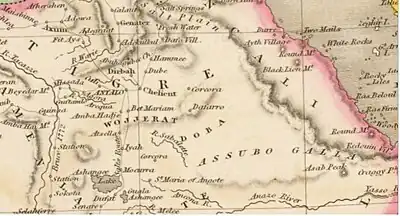Doba (historical region)
Doba was a historical Muslim region in central modern Ethiopia.[1] Historian Fesseha Berhe associates Doba with the Saho people.[2] The people of Doba are considered extinct today.[3]

History
Doba region was mostly populated by pastoralists.[4]
The people of Doba are linked to the Argobba aristocracy of Walasma.[5] Argobba people consider the inhabitants of Doba their ancestors.[6] Doba territory was within the 13th century Ifat state.[7]
In the 14th century Doba neighbored Tigray, Angot, and Amhara regions of modern Ethiopia.[8]
According to Ayele Tariku, in the 1400s emperor Yeshaq I had placed a military battalion called Jan Amora near Doba country to protect the Abyssinian frontier against attacks from the people of Doba.[9]
During the reign of Emperor Baeda Maryam I in the late fifteenth century, the Doba bordering Angot are recorded to have disrupted crucial roads used for Abyssinian trade.[10] Baeda Maryam I would incorporate the Doba peoples into his army after invading their region.[11][12]
Doba are reported to have lived in Tigray Province in the 16th century.[13]
Later in the seventeenth century the induction of Doba and Harla peoples into Afar identity led to the emergence of the Aussa Sultanate.[14] During the reign of Emperor Iyasu II in the 1700s, Doba warriors attacked the Abyssinian frontier.[15]
References
- Menasbo, Negga. HISTORY AND IDENTITY IN NORTHEAST ETHIOPIA WITH PARTICULAR REFERENCE TO RAYA-AZӒBO, 1543-1974 (PDF). Addis Ababa University. p. 68.
- Berhe, Fesseha. Regional History and Ethnohistory Gerhard Rohlfs and other Germanophone Researchers and a Forgotten Ethnic Group, the Dobʿa (PDF). Mekelle University. p. 128.
- Levine, Donald. Greater Ethiopia The Evolution of a Multiethnic Society. University of Chicago Press. p. 69.
- Ahmed, Hussein. Islam in Nineteenth-Century Wallo, Ethiopia. BRILL. p. 8.
- Kifleyesus, Abebe. Tradition and Transformation The Argobba of Ethiopia. Harrassowitz. p. 44.
- Asfaw, Aklilu. A short History of the Argobba. Annales d'Éthiopie. p. 179.
- Ifat. Encyclopedia Aethiopica.
- Tamrat, Tadesse. Church and state (PDF). University of London. p. 154.
- Tariku, Ayele. The Christian Military Colonies in Medieval Ethiopia: The Chewa System. SAGE publications. pp. 179–306.
- Mordechai, Abir. Ethiopia and the Red Sea The Rise and Decline of the Solomonic Dynasty and Muslim European Rivalry in the Region. Taylor & Francis. pp. 34–35.
- Demisse, Yonas. Bringing the Slaves Back InCaptives and the Making and Unmaking of the Premodern Ethiopian State. Duke University Press. pp. 261–279.
- Trimingham, J.Spencer. Islam in Ethiopia. Taylor & Francis. p. 81.
- Cerulli, Ernesta. Peoples of South-West Ethiopia and Its Borderland North Eastern Africa Part III. Taylor & Francis.
- Bausi, Alessandro. Ethiopia History, Culture and Challenges. Michigan State University Press. p. 83.
- Budge, E.A. A History of Ethiopia: Volume II (Routledge Revivals): Nubia and Abyssinia. Routledge. p. 456.